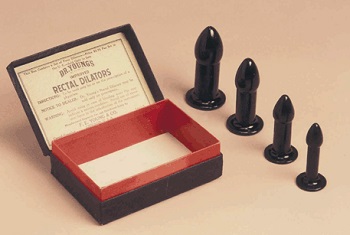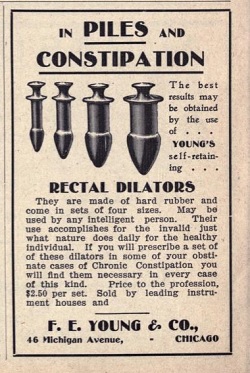5 Nightmarish Ways People In History Solved Common Problems

Some people say that necessity is the mother of invention. If that were true, we'd all be eating zero-calorie buffalo wings while driving around in saltwater-powered cars on our way to the gym to repeatedly punch a clone of Hitler in the face. As history has shown us, the greatest ideas have been formulated by maniacal geniuses who were willing to totally disregard human life, labor laws, and basic sanity to get what they wanted. Sometimes, that attitude gets us a visionary madman like Thomas Edison or Henry Ford -- but that's if we're lucky.
All the other times, well, the following happens.
Constipated? Cure It By, Uh, Wearing A Huge Buttplug!
Today, 42 million Americans or more are suffering the agonies and indignities of constipation -- those are some solid numbers. In fact, healthcare costs for constipation-related emergency room visits are estimated at $1.6 billion, enough to make any health insurance agent shit a collective brick of their own. The U.S. is a nation of gastrointestinally challenged people. Always has been. But the things it has done for the sake of relief will tighten those sphincters right back up.

In the late 1800s, when our great-great-grandparents were young, they too were into butt stuff. It was believed that one way to cure constipation was to power a four-inch doughboy up your kaiser and leave it there overnight. This idea was first inspired by a surgical device affectionately referred to as a "bougie." It was used by medical professionals to aid the defecation process by simulating the type of anal widening that occurs naturally only after a five-course meal at your local discount burrito joint. From there, it didn't take long for some enterprising spirit to come up with a do-it-yourself kit. And that's when the good times started.
As mentioned in one of our many, many previous articles on butt stuff, the devices were also sold over the counter as Dr. Young's Ideal Rectal Dilators, and at $2.50 a box, they weren't always sold for strictly medical purposes. Not content to just advertise them as a rock poop excavator, "Dr." Young claimed his dilators were a cure-all, much like snake oil (which did come in handy during the insertion process). Even "three-fourths of all the howling maniacs of the world" could be completely cured "in a few weeks' time by the application of orificial methods."
It didn't take long before business was booming. The rectal dilators even evolved with time, first fashioned from hard rubber, then Bakelite (an old-timey formaldehyde-based plastic), and finally aluminum. They also varied in size and came in sets so that you could acclimate, but once you decided to use a dilator, there was no turning back. Like ear stretchers, but this time for literal assholes.
Skepticism for these laxative dildos quickly leaked out of the media, but the government was too backed up to quickly pass any regulations. Public access medical devices as a whole were not regulated by the FDA until 1938. Two years later, the administration finally called shenanigans on Dr. Young's metallic butt-corks, and they were banned -- not because of the health risk or the whole illegal sexual arousal but simply because of false advertising. Since Dr. Young had made the weirdly disprovable promise that if you used them you'd never be constipated again, even the courts in those days agreed that such a claim was nonsense. They clearly thought that he was stretching the truth. You could even say that his story had some gaping holes in it.
That was the last one. Promise.
Unruly Prisoners? Soldiers? Here's A Spanking Machine!
Today, the internet's awash in debates about the morality of physically disciplining your children, but in the golden days of yesteryear, many people were concerned only with how best to beat the crap out of their little angels. And teenagers. And adults. They weren't picky. If they could be put over a knee, a spanking was always Plan A. It was a simpler time.
So in the nascent age of technology, inventors from all over the world answered the call, designing various machines to make spankings easier on the spankers and more memorable for the spankees. Take, for example, German inventor Otto Tuchenhagen's patent for a "corporal punishment machine for automatic whipping" -- no supervision needed! -- for criminals in prison. The machine was patented in the '70s and is described thusly:
Yes, America has been dreaming of butt-slapping automata for decades. In 1920, spanking machines made headlines when The New York Evening World and The New York Tribune each ran stories about Mayor Arthur Whitaker (of the New Jersey Whitakers), who, in a desperate attempt to keep all those wayward teens out of prison, implemented a "spanking squad" tasked with grabbing the kids and using the machine to administer the punishments. The squad apparently consisted of just two officers: one to spank and one to watch.
To keep kids away from a life of laudanum and jazz, Mayor Whitaker made little effort to dissuade concerned parents that his town actually owned a spanking Terminator that was beating the shit out of their kids. As Whitaker warned, "If the moral effect should be lost now that the public knows just what the 'machine' is, why then, we will rig up a really, truly mechanical spanker to take the place of the barrel stave, and it will have some jolt to it too, on the spot where it fetches up." (There's a reelection slogan if ever there was one.)
In the end, the number of kids sent to reformatories declined markedly once the machine started swinging, and -- if the mayor is to be believed -- the kids who went through his machine actually came to trust him with their problems later in life, which, as every dominatrix knows, is the truly rewarding part of the job.
Of course, because the military loves both efficiency and harsh discipline, one of the spanking machines was lent to the brave soldiers at Fort Custer, Michigan. But the Spankulator 3000 wasn't used to punish particularly naughty soldiers. The Augusta training base implemented the device to teach a soldier to fire his rifle properly. If he didn't squeeze it just right, a spring-loaded paddle would whack the poor guy in the ass until he could figure out how to hit a bull's-eye.
Unfortunately, there exist no studies that documented how effective this bottom-heavy marksmanship method was. But we did win World War II, so what more proof do you need?
Worried About Burglars? Turn Your Floor Into A Minefield!
You know what would have improved Home Alone? If the Wet Bandits had taken one step inside the McCallister household and immediately had their legs blown clean off like they had accidentally stumbled into the Korean DMZ. If that sounds like a harsh punishment for some light breaking-and-entering, you're obviously not a descendant of whoever looked at the discovery of the most volatile explosive known to man and thought, "I should use that to keep my valuables safe."
It was called the "explosive burglar alarm," and the idea behind it was simple: Before heading to bed for some typical turn-of-the-century unenthusiastic sex, homeowners would sprinkle their floors with powdered iodine and powdered ammonia. When these chemicals met, they would form a contact explosive that would be sparked by the slightest touch or vibration. Should a burglar step into the house, well, this would happen:
Shockingly, this alarm system has a few drawbacks. Seeing as even a feather (or, say, a common housefly) can trigger the powder to explode, every night's rest will play out like the opening scene of The Hurt Locker. Without a good night's sleep, it's also going to be extra hard to MacGyver an armor-plated dressing gown and broom for when you have to clean up the remaining explosives in the morning. Luckily, because of the toxicity and flammability, it probably means you'll get to use the trick only once anyway.
Lastly, in small batches, the substance will only lead to minor burns and maybe a damaged shoe. But when an adult-size criminal stumbles back from that first flash and falls flat down on a floor covered in the powdery substance? Cheapest red paint job you'll ever get.
Want To Lower Your Taxes? Get Rid Of All Your Tenants' Windows!
Even today, asking a British person how much money they make would cause their inner monocle to pop off and their throat to involuntarily start harrumphing. So back in 17th century, even the British government preferred other ways to guess how wealthy someone was. Their favorite means of judging was to simply look at the state and size of their house. Then, in 1696, a revolutionary new form of taxation was proposed: to tax citizens based on how many windows they had. A brilliantly unobtrusive plan, to be sure, but what the government hadn't considered was just how far most homeowners would go to abuse a tax loop, even if it meant giving up things like fresh air and daylight.

Under the rule of William III, the British government started to charge homeowners a window tax. They had previously failed this approach with the much-hated hearth tax, which required a "chimney man" to barge into people's houses every so often to count their fireplaces and poke around their stuff. But this progressive window tax was both simpler and fairer. Not only did it punish slumlords for building massive tenements (people in small houses were basically exempt), it was a revenue stream even the most incompetent bureaucrat could enforce, because you can easily count a building's windows by just standing on the street outside.
In 17th-century England's cities and towns, the poor and working-class citizens rarely owned homes of their own -- unlike today, when everyone under 40 can't either. Large windows in many rooms were one of the only selling points slumlords had to make their tiny rooms seem more palatable to poor families. But these dastardly windows were now cutting into their profit margins, so tax-evading owners simply started bricking up whole rows of windows, turning their tenants into Morlocks.
But darkness wasn't the only downside. A lack of fresh air quickly caused a public health crisis as diseases such as typhus, smallpox, and cholera ran rampant inside these five-story hotboxes.
The child in the foreground, having spent his entire life in a toxic abyss, seems to have grown an extra leg.
Even though it was meant as a progressive, screw the 1 percent, egalitarian act, the tax became extremely unpopular, causing waves of campaigns by medical officials, lobbyists, and ordinary people who were tired of literally living in the shadows. The problem was so widespread that complaining about it became a popular subgenre of pop music (we're still holding out for "Elegy Of The Mole-Man" to make a comeback on the charts). But thanks to British bureaucracy, it would be 156 years before city-dwellers would be granted the right to see daylight again from anywhere inside their homes. To this day, there are buildings in major cities whose bricked-over windows have not been replaced. Though we're sure that's just to keep the Dickensian mutants bricked in.
Sick Of Running People Over? Scoop Their Asses Away!
For as long as there have been cars, there have been people getting knocked over by said cars. Barring bubble suits for everyone, this is an unsolvable problem. Or that's what you might think, at least. A perfectly fine solution has been lying on the table since the 1920s. No, silly, it's not stopping people from driving like maniacs; it's scooping up pedestrians with a massive net.
A poor man is a rich man's Pokemon.
The device, which could easily be mounted onto the front of a car, consisted of a cradle, a net, and (we can only presume) every four-leaf clover and horseshoe in the known universe. If the car were to hit a pedestrian, they'd theoretically be thrown into the seat-shaped net for a comfortable ride, instead of being reduced to an unsightly hood ornament on someone's Model T. It sounds stupid, but they actually found someone ballsy enough to test the device. And it worked! Twice!
Imagine what sort of world we'd be living in if this had caught on. Imagine how quickly rich people would invent some sport centered around scooping and tossing poor people to each others' Bentleys. And the kidnappings! What a world. At least hit-and-runs would become a bit of a hassle, as drivers would have to untangle their victim out of their car hammock before speeding off.
"This is awful ... I just had this net washed."
Of course, the biggest flaw was that you'd have to hit the pedestrian directly from behind or else they wouldn't fall into the seat. And encouraging people to instinctively swerve toward pedestrians probably would increase the amount of vehicular accidents, not lessen them. Not to worry, only a few years later, someone else invented a "roller safety device" for cars that could sweep those dead pedestrians to the side. Now that's the kind of invention that Nobel Prize speeches were made for.
When they aren't rocking your world with bad puns and harsh truths, Marina and Adam can be found on Twitter.
Also check out The 5 Most Ridiculously Unnecessary Modern Inventions and 6 "World-Changing" Inventions (That Didn't Change Shit).
Subscribe to our YouTube channel, and check out 11 Sex Toys Seemingly Designed To Ruin Sex, and other videos you won't see on the site!
Also, follow us on Facebook, and let's be best friends forever


















